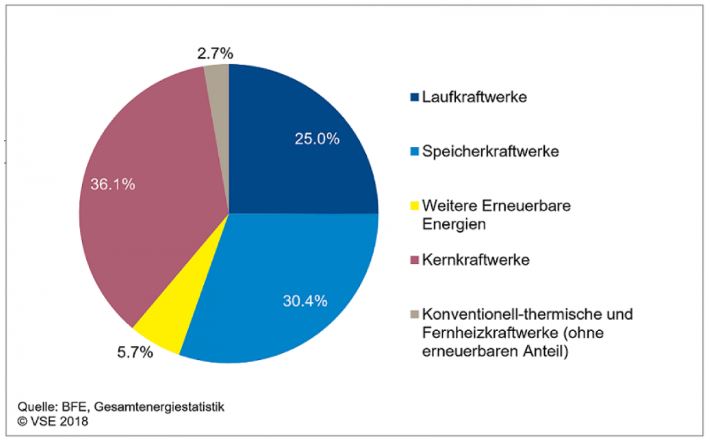Run-of-river power plants are built on rivers and use the energy of water flowing down a gradient. In most cases, this is only a few meters, but since several hundred tons of water can flow down per second, run-of-river power stations can have a large capacity of several megawatts (MW). The water flow spins turbines, which converts kinetic rotational energy to electrical energy.1
Energy Output in Switzerland
Due to the even flow velocity of rivers, the output is also constant throughout, i.e. hydroelectric power plants supply reliable band energy around the clock 24/7, although this is subject to seasonal fluctuations. As a general rule, the effective annual production of all hydroelectric power plants fluctuates plus/minus 20 percent depending on precipitation, runoff and (storage) management.
In Switzerland, the rivers Aare, Reuss and Rhine in particular are used intensively to produce hydroelectricity. On the High Rhine between Schaffhausen and Birsfelden (BL) alone, eleven run-of-river power plants with an installed capacity of around 830 MW produce an average of around 5 TWh of electricity per year. A total of 4132 MW of capacity is available in run-of-river power plants in Switzerland to produce around 17,800 GWh of electricity annually.2

source: www.strom.ch
Run-of-river power plants are divided into large hydropower (more than 10 MW capacity) and small hydropower. For this purpose, power plants are also differentiated according to the gradient that they can exploit. This is because the greater the gradient, the greater the pressure with which the water drives the turbines. This is why there are low-pressure (gradient up to 15 meters), medium-pressure (up to 400 meters) and high-pressure power stations.
Low-pressure power plants dominate the run-of-river power generation. The useful gradient there is around 10.5 meters, the turbines can process a water volume of 400m3/s, have a capacity of 37 MW and produce an average of 244 GWh of electricity.
What's the current situation in Switzerland?
The energy generated by run-of-river power plants is highly dependent on the water flow of Swiss rivers. In the past, glaciers were able to guarantee a majority of the water supply to the rivers. In the meantime, the glaciers have almost completely melted and climate change is to blame. The water supply of the rivers is now only through groundwater or through springs and precipitation directly. This could result in more irregular energy production. Water insecurity thus also affects hydropower production.
The largest ROR on our planet
The largest hydro power plant is a ROR. It's called the "Three Gorges Dam" that spans the Yangtze River by the town of Sandouping, in Yiling District, Yichang, Hubei province, central China. The annual electricity generation in 2018 was 101.6 TWh.3
[please upload the image again in the correct way]
source: www.china.org.cn
Which of these countries produces the most hydroelectric energy worldwide?
Have a guess! :)
☐ Canada
☐ China
☐ Brazil
Sources:
1 www.axpo.ch
2 www.wikipedia.org
3 www.wikipedia.org